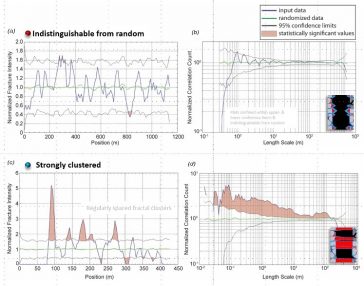Natural fractures are increasingly recognized to result from processes that couple mechanical failure and chemical reactions. Chemical reactions aid fracture growth through stress corrosion, whereas sealing, tip blunting, and crack-jump in response to chemical mass transfer and creep processes can impede further fracture growth and alter size and spacing patterns. Chemical-mechanical interactions affect spatial and temporal patterns of fracture network evolution and their interpretation, fault stability, and fracture and fault flow properties.

Increased spanning potential correlates with fracture clustering, Cretaceous Frontier Formation sandstone (after Li et al. 2018 using normalized correlation count method of Marrett et al. 2018). Spanning potential: Lander and Laubach, 2015 (insets). (a, b) Low spanning potential; clustering indistinguishable from random; (c, d) High spanning potential; hierarchical clustering.
Our ongoing research is testing how natural cement accumulates in fractures, how cement deposits can be used to reconstruct fracture history, and how interacting chemical-mechanical processes affect the size distribution, spatial organization, strength, porosity, and permeability of fracture arrays. Fracture mechanics has been central to interpreting opening-mode fractures in rock, but our results show that mechanics must be coupled with geochemical principles to understand how fracture porosity, spacing, size and connectivity evolve. We are developing crystal growth models that predict cement accumulation patterns and volumes in fractures and are incorporating these diagenetic features into geomechanical models of fracture pattern evolution, showing how evolving rock mechanical properties and the mechanical interaction of cement accumulation and fracture growth can influence pattern geometry and fluid flow attributes.
We recently developed new approaches and software to quantify spatial organization. Laboratory tests we are developing provide key rock and fracture mechanical constraints. A breakthrough is our demonstration that fracture growth and diagenesis interact to create and destroy fracture porosity, and evidence of this process is preserved in quartz cement deposits in partially open fractures. We showed that using cement textures and fluid inclusion data combined with burial histories allows inference of duration and rates at which fractures open, allowing unprecedented comparison of fracture growth models with natural examples.
Although our study focuses on fractures in sandstone, our results show that these structural-diagenetic principles apply to all rock types. Using fracture pattern reconstruction approaches on subsurface data sets we are testing the evolving models. But for fully testing predictions of fracture size and spatial arrangements, models require validation in special outcrops, where fractures have diagnostic features that show they are like those in the deep subsurface. In September 2018, we led a symposium field trip to some of these outcrops, as described on our site under field symposia.
Two new PhD dissertation projects have recently started that focus on outcrop and horizontal core data sets. The studies are investigating examples where the interaction between cement deposition and fracture widening correlates with differences in many key fracture pattern attributes, including length, height, and aperture.
Selected recent references grant DE-FG02-03ER15430 from Chemical Sciences, Geosciences and Biosciences Division, Office of Basic Energy Sciences, Office of Science, U.S. Department of Energy: Links to papers on Publications page
- Laubach, S.E., Lamarche, J., Gauthier, B.D.M., Dunne, W.M., and Sanderson, D.J., 2018. Spatial arrangement of faults and opening-mode fractures. Journal of Structural Geology 108, 2-15.
- Marrett, R., Gale, J.F.W., Gomez, L., and Laubach, S.E., 2018. Correlation analysis of fracture arrangement in space. Journal of Structural Geology 108, 16-33. doi.org/10.1016/j.jsg.2017.06.012
- Li, J.Z., Laubach, S.E., Gale, J.F.W., and Marrett, R., 2018. Quantifying opening-mode fracture spatial organization in horizontal wellbore image logs, core and outcrop: application to Upper Cretaceous Frontier Formation tight gas sandstones, USA. Journal of Structural Geology 108, 137-156. doi.org/10.1016/j.jsg.2017.07.005
- Hooker, J.N., Laubach, S.E., and Marrett, R., 2018. Microfracture spacing distributions and the evolution of fracture patterns in sandstones. Journal of Structural Geology 108, 66-79. doi.org/10.1016/j.jsg.2017.04.001
- English, J.M., and Laubach, S.E., 2017. Opening-mode fracture systems – Insights from recent fluid inclusion microthermometry studies of crack-seal fracture cements. In Turner, J.P., Healy, D., Hillis, R.R., and Welch, M., eds., Geomechanics and Geology: Geological Society, London, Special Publications, 458, 257-272. doi:10.1144/SP458.1
- Laubach, S.E., Fall, A., Copley, L.K., Marrett, R., Wilkins, S., 2016, Fracture porosity creation and persistence in a basement-involved Laramide fold, Upper Cretaceous Frontier Formation, Green River Basin, U.S.A. Geological Magazine 153 (5/6), 887-910. doi:10.1017/S0016756816000157
- Ukar, E., Laubach, S.E., Marrett, R., 2016, Quartz c-axis orientation patterns in fracture cement as a measure of fracture opening rate and a validation tool for fracture pattern models: Geosphere 12 (2), 400–438, doi: 10.1130/GES01213.1
- Fall, A., Ukar, E., Laubach, S.E., 2016. Origin and timing of Dauphiné twins in quartz cement in fractured sandstones from diagenetic environments: insight from fluid inclusions. Tectonophysics 687, 195-209. doi.org/10.1016/j.tecto.2016.08.014
- Lander R.H., and Laubach, S.E., 2015, Insights into rates of fracture growth and sealing from a model for quartz cementation in fractured sandstones. Geological Society of America Bulletin 127 (3-4), 516-538. doi: 10.1130/B31092.1
© 2025 Jackson School of Geosciences, The University of Texas at Austin


